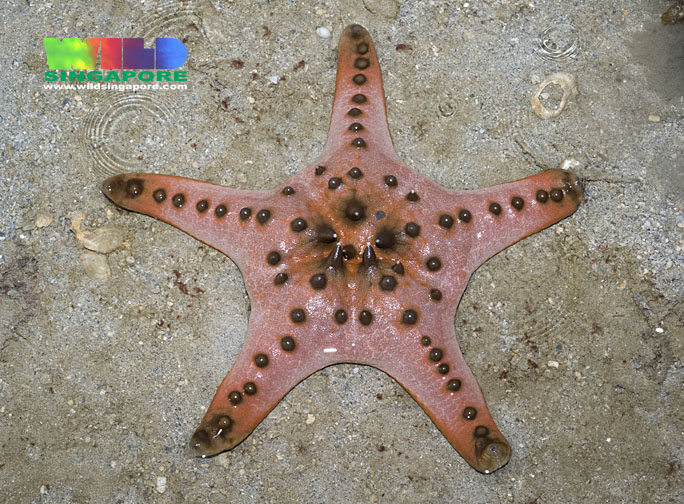Colours
Distinguishing features
They possess rows of spines or "horns"; black conical points arranged in a single row, radially on the dorsal side, which may erode and become blunt. These dark protrusions are used to scare away possible predators, by looking frightening or dangerous. On the ventral side, tube feet, purple in color (or pale, transparent pink), are arranged in rows on each arm. Most horned sea stars found are a roughly rigid five-pointed star-shape with tapering arms to the end, although there are anomalies like four or six-armed specimens. �
They are usually colored in shades of red or brown, but can be light tan, the color of cookie dough. This appearance, combined with the small horns on its dorsal side, give the sea star a look similar to that of a bumpy cookie. (Wikipedia)
Size
- Up to 30 cm (Diameter)
Depth range
- Depth range data is not yet available.
Synonyms
Distribution
Distribution and habitat preferences
They prefer sheltered, sandy or slightly muddy bottoms more than hard substrata such as coral reef, and are frequently sighted conspicuously between the leaves of seagrasses on sea grass meadows or on blank stretches of coral sand.
In shallow water, this species can be seen intertidally, occasionally exposed to the low tide. they do not withstand rapid changes well, however, and usually keep themselves underwater. (Wikipedia)
Local abundance
- Lizard Island, Queensland, Australia: Uncommon
Behaviour
Sometimes, many individuals can be seen gathering on the soft bottom but the reason for this is not very well known; possibly to increase the chance of fertilization when spawning or simply because it is a suitable feeding ground. (Wikipedia)
Web resources
References
- Clark, A.M. and F.W.E. Rowe (1971). Monograph of shallow-water Indo-west Pacific echinoderms British Museum (Natural History), London.
- Coleman, N. (2007). Sea Stars: Echinoderms of the Asia/Indo-Pacific Neville Coleman's Underwater Geographic, Springwood, Qld. Australia.
- Rowe, F.W.E. and J. Gates (1995). Echinodermata in: Zoological Catalogue of Australia. Vol. 33, xiii, 510 pp. Wells, A. (Ed.). CSIRO, Melbourne, Australia.


